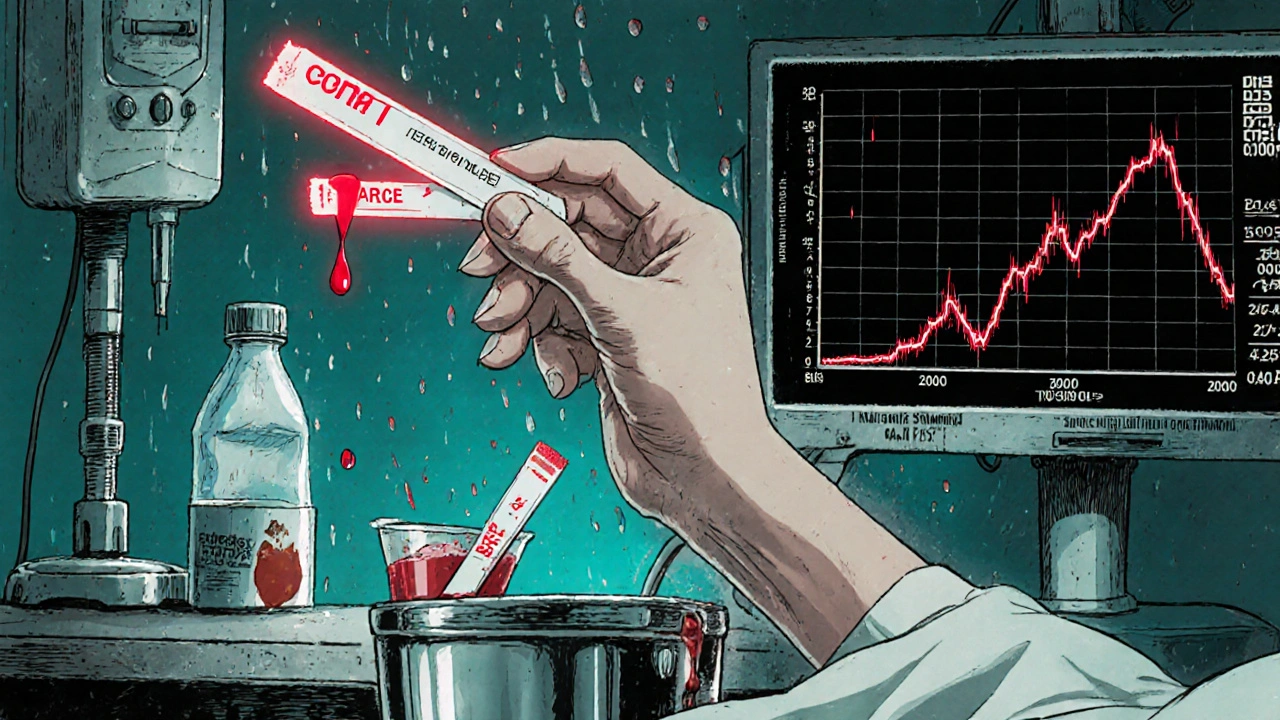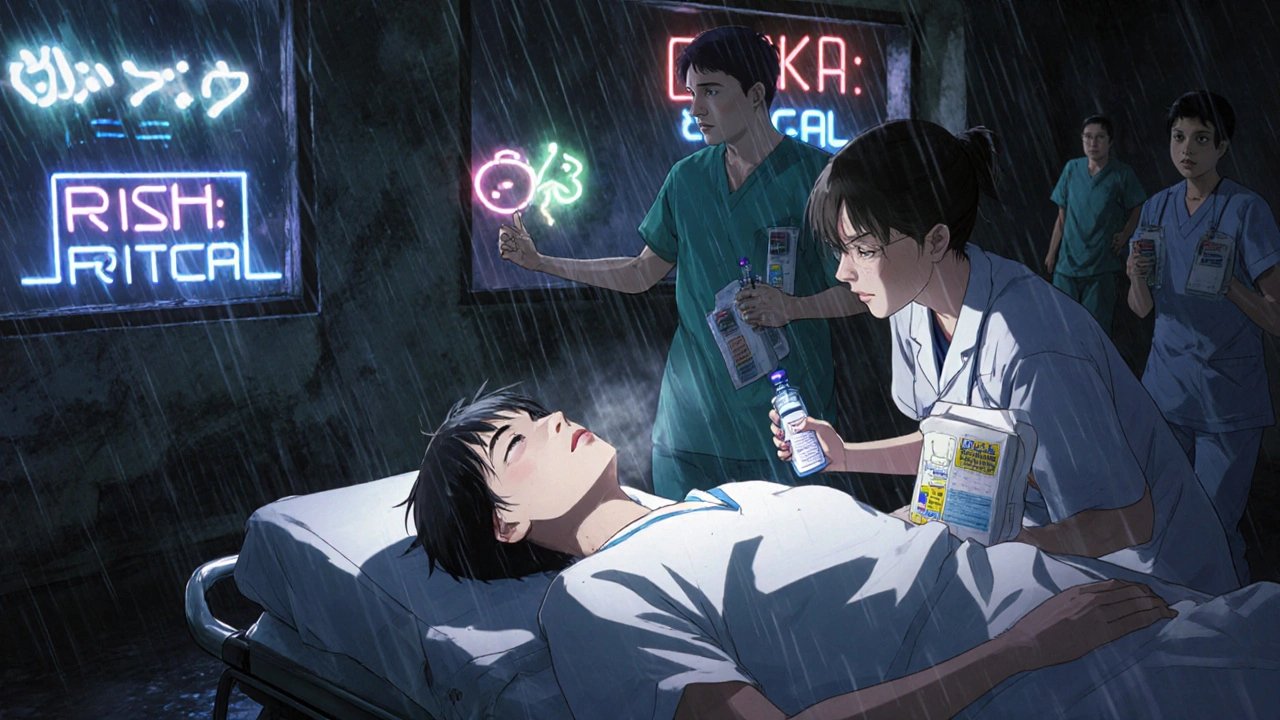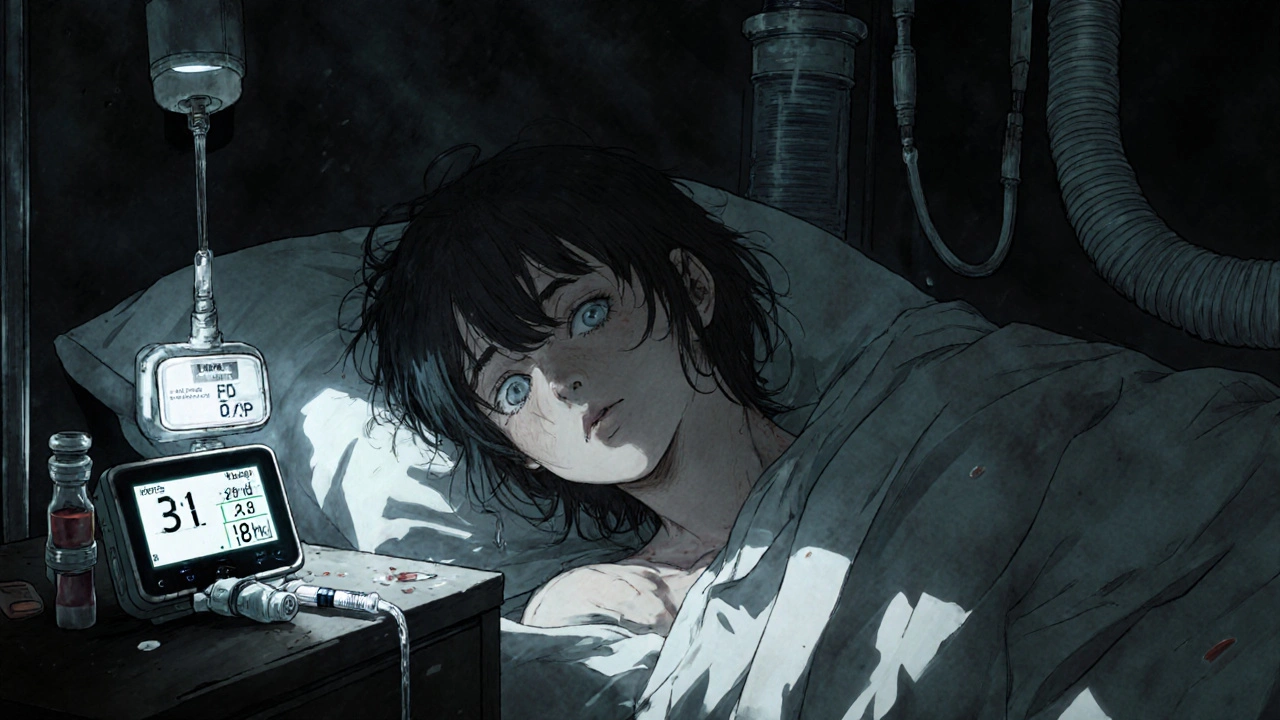When You’re Sick and Have Diabetes, Your Body Is Under Stress
Getting a cold, flu, or stomach bug is hard enough. But if you have diabetes, especially Type 1, a simple illness can turn dangerous fast. Your body releases stress hormones like cortisol and adrenaline when you’re sick - even if you’re just feeling under the weather. These hormones fight off infection, but they also make your liver pump out extra glucose. At the same time, your body becomes more resistant to insulin. The result? Blood sugar can spike to 250, 300, or even higher - even if you’re not eating. And if you skip insulin because you’re not hungry, you’re putting yourself at risk for diabetic ketoacidosis (DKA), a life-threatening condition that sends over 27% of diabetes-related hospital admissions in the U.S. every year.
Never Skip Your Basal Insulin - Even If You Can’t Eat
This is the most important rule: never stop your long-acting insulin - not for a single dose. Whether you take Lantus, Levemir, Basaglar, or use an insulin pump, your body still needs background insulin to stop your liver from flooding your bloodstream with glucose. Skipping it, even for one day, is the #1 cause of DKA during illness.
For Type 1 diabetes, you might need to increase your basal rate by 20% if your blood sugar stays above 240 mg/dL for more than two checks, or if you have moderate to large ketones. For pump users, this means adjusting your temporary basal rate for at least 12 hours. For those on injections, you may need to take an extra 10-20% of your usual daily dose, split into two or three smaller doses. Don’t guess - check your blood sugar every 2-3 hours and call your doctor if you’re unsure.
People with Type 2 diabetes on insulin also need to keep taking it. Those on oral meds only might not need insulin right away - but if your blood sugar stays above 240 mg/dL for more than 12 hours, or if you start feeling nauseous or fatigued, it’s time to talk to your provider. Some Type 2 patients end up needing temporary insulin during illness, even if they’ve never used it before.
Check Ketones - But Know How to Read Them Right
Ketones are your body’s backup fuel when it can’t use glucose. When insulin is low and glucose is high, your body burns fat instead - and that produces ketones. Small amounts are normal. Large amounts? That’s DKA waiting to happen.
Test for ketones when your blood sugar hits 240 mg/dL or higher. If you have a blood ketone meter, use it. Blood ketone strips are more accurate than urine strips, which can be delayed by hours. Blood ketone levels mean:
- Below 0.6 mmol/L - Normal, no action needed
- 0.6-1.5 mmol/L - Moderate ketones. Increase fluids, check every 2 hours, and consider a 10-20% insulin increase
- Over 1.5 mmol/L - High ketones. Take immediate action: give a correction dose, change your pump site if you use one, and call your doctor. If you’re vomiting or confused, go to the ER.
Urine ketone strips say “trace,” “small,” “moderate,” or “large.” If it’s moderate or large, treat it like a blood ketone over 1.5 mmol/L. Don’t wait. Don’t assume it’s “just a little.” Many people who end up in the hospital with DKA thought their ketones were “not that bad.”
Stay Hydrated - But Not Just Any Fluid
When you’re sick and your blood sugar is high, your kidneys flush out extra sugar through urine. That pulls water out of your body - fast. Dehydration makes ketones worse and makes your blood sugar harder to control.
Drink fluids every hour. Adults should aim for 6-8 ounces per hour. Kids need about 1 ounce per year of age - so a 10-year-old needs 10 ounces every hour. But what you drink matters just as much as how much.
- If your blood sugar is above 180 mg/dL - stick to sugar-free fluids: water, unsweetened tea, broth, or sugar-free electrolyte drinks like Pedialyte.
- If your blood sugar is between 100 and 180 mg/dL - alternate between water and fluids with 15 grams of carbs: half a cup of regular soda, half a cup of juice, or a quarter cup of Gatorade. This keeps you hydrated without spiking sugar too high.
- If your blood sugar is below 100 mg/dL - drink fluids with carbs to prevent lows: regular soda, juice, or oral rehydration solutions.
Don’t rely on “clear fluids” alone. Many people think chicken soup or broth is enough. But if you’re not getting carbs when needed, you risk a dangerous low. And if you’re drinking sugary drinks when your sugar is already high, you’re feeding the fire.

Keep Eating - Even If You’re Not Hungry
You don’t need to eat a full meal. But your body still needs fuel. Skipping food doesn’t lower your blood sugar if you’re not taking insulin - it just makes your body burn more fat and produce more ketones.
Try to get 15 grams of carbohydrates every hour if you can. Easy options:
- 1/2 cup applesauce
- 1/2 cup regular gelatin
- 1 slice of toast
- 1/2 cup canned fruit in juice (not syrup)
- 1 small banana
- 1 tablespoon honey or jam
If you’re vomiting or can’t keep anything down, try sipping small amounts every 10-15 minutes. If you can’t keep fluids down for more than 4 hours, call your doctor or go to the ER. IV fluids are often needed to break the cycle of dehydration and high ketones.
What to Keep in Your Sick Day Kit
Don’t wait until you’re sick to prepare. Build a sick day kit now. Here’s what to include:
- Extra insulin (at least 7 days’ supply)
- Unopened ketone test strips (check expiration - strips lose accuracy after 6 months of opening)
- Blood glucose meter with extra batteries
- Glucagon emergency kit (if you’re on insulin)
- 15g carb snacks: juice boxes, glucose tabs, honey packets
- Sugar-free electrolyte drinks
- Measuring cup (to track fluid intake accurately)
- List of emergency contacts and your doctor’s phone number
Store it in a cool, dry place. Check it every 3 months. Expired strips or insulin can give you false readings - and that’s how people end up in the hospital.
Pump Users and CGM Users: Special Considerations
If you use an insulin pump or continuous glucose monitor (CGM), your sick day plan needs tweaks.
- Change your infusion site if your blood sugar stays high for more than 2 hours - even if the site looks fine. Blockages can happen without warning.
- Don’t turn off your pump. Even if you’re not eating, your body still needs insulin.
- Use your CGM trends. If more than half your readings are above 250 mg/dL for 12 hours straight, treat it like a high ketone reading - even if you haven’t tested ketones yet.
- Some pumps have “sick day mode.” Check your manual. Not all do.
One major gap in current guidelines? Closed-loop systems. These “artificial pancreas” devices automatically adjust insulin - but they’re not designed to handle the extreme insulin resistance of illness. Many users report their systems under-deliver insulin during sickness. You may need to override the algorithm and manually increase basal rates. Always have a backup plan.

When to Call for Help - Don’t Wait
These are red flags. Call your doctor or go to the ER immediately:
- Blood ketones over 1.5 mmol/L
- Vomiting for more than 4 hours
- Confusion, trouble breathing, or fruity-smelling breath
- Weight loss of 5 pounds or more in a few days
- Blood sugar above 300 mg/dL for more than 6 hours, even after correction doses
- You can’t keep any fluids down
Don’t wait to see if it gets better. DKA doesn’t wait. The CDC says 2-5% of DKA cases are fatal - and most happen because people delayed getting help.
Common Mistakes People Make (And How to Avoid Them)
- Mistake: Skipping insulin because you’re not eating. Solution: Basal insulin is not optional - it’s your lifeline.
- Mistake: Using old urine ketone strips. Solution: Buy blood ketone meters. They’re faster, more accurate, and worth the cost.
- Mistake: Drinking sugary drinks when blood sugar is high. Solution: Stick to sugar-free fluids unless your sugar is dropping.
- Mistake: Taking OTC cold meds without checking labels. Solution: Many contain sugar, alcohol, or decongestants that raise blood sugar. Look for “sugar-free” and “diabetic-friendly” labels.
- Mistake: Thinking “I feel fine, so I’m okay.” Solution: Illness can hide symptoms. Check numbers - don’t rely on how you feel.
What You Can Do Today to Be Ready
Don’t wait until you’re sick to learn this. Right now:
- Check your ketone strips’ expiration date.
- Make sure your insulin isn’t expired.
- Write down your doctor’s number and keep it on your phone.
- Practice measuring 8 ounces of fluid - so you know what it looks like.
- Call your diabetes clinic and ask for their sick day handout. If they don’t have one, ask for a referral to a certified diabetes care and education specialist.
Diabetes doesn’t take a sick day. Neither should you. Being prepared means you won’t panic when you get sick. You’ll know what to do - and you’ll stay safe.
Should I stop my insulin if I’m not eating when I’m sick?
No. Never stop your long-acting insulin, even if you’re not eating. Your body still needs insulin to prevent your liver from releasing too much glucose. Skipping insulin during illness is the leading cause of diabetic ketoacidosis (DKA). You may need to increase your dose slightly, but you should never reduce it to zero.
How often should I check my blood sugar when I’m sick?
Check every 2-3 hours if you have Type 1 diabetes or are on insulin. For Type 2 diabetes on oral meds only, check every 4 hours. If your blood sugar is rising or you have ketones, check more often - every hour if needed. Don’t wait until you feel worse.
Are urine ketone strips reliable?
They’re better than nothing, but not ideal. Urine strips can be delayed by hours, so they might show low ketones when your blood ketones are already high. Blood ketone meters give real-time results and are the gold standard. If you only have urine strips, treat moderate or large results the same as blood ketones over 1.5 mmol/L.
Can I take over-the-counter cold medicine if I have diabetes?
Yes - but check the label. Many cold medicines contain sugar, alcohol, or decongestants like pseudoephedrine, which can raise blood sugar. Look for “sugar-free” and “diabetic-friendly” labels. Avoid syrups if possible. Ask your pharmacist for help - they’re trained to spot hidden sugars.
When should I go to the ER during a sick day?
Go to the ER if you have vomiting for more than 4 hours, blood ketones over 1.5 mmol/L, confusion, trouble breathing, fruity-smelling breath, or if you can’t keep any fluids down. Also go if your blood sugar stays above 300 mg/dL for more than 6 hours despite correction doses. These are signs of DKA - a medical emergency.
Do I need to check ketones if I have Type 2 diabetes?
Yes - if you’re on insulin. If you’re only on oral medications, you don’t need to check ketones unless your blood sugar stays above 240 mg/dL for more than 12 hours. But if you feel unusually tired, nauseous, or have trouble breathing, get checked anyway. Some Type 2 patients can still develop DKA, especially if they’re severely dehydrated or have an infection.
Can I use a continuous glucose monitor (CGM) to manage sick days?
Yes - but don’t rely on it alone. CGMs show trends, which are very helpful. If over half your readings are above 250 mg/dL for 12 hours, treat it like a high ketone reading. But CGMs don’t measure ketones. You still need a blood ketone meter. Also, CGMs can be inaccurate during illness due to dehydration or inflammation.

Chris Vere
November 22, 2025 AT 00:23And honestly? The fact that they included hydration guidelines based on blood sugar levels? That's next level. Most guides just say 'drink water.' This tells you when to drink water and when to drink something with sugar. That's the difference between a pamphlet and a lifeline.
Pravin Manani
November 23, 2025 AT 22:23Leo Tamisch
November 25, 2025 AT 07:23Clifford Temple
November 26, 2025 AT 07:46Corra Hathaway
November 26, 2025 AT 17:49Shawn Sakura
November 27, 2025 AT 17:18ps. I typoed ‘ketones’ as ‘ketons’ twice. Sorry. 😅
Paula Jane Butterfield
November 27, 2025 AT 22:25Simone Wood
November 29, 2025 AT 08:30Swati Jain
November 29, 2025 AT 23:01Florian Moser
November 30, 2025 AT 21:44jim cerqua
December 2, 2025 AT 19:02Donald Frantz
December 3, 2025 AT 01:06